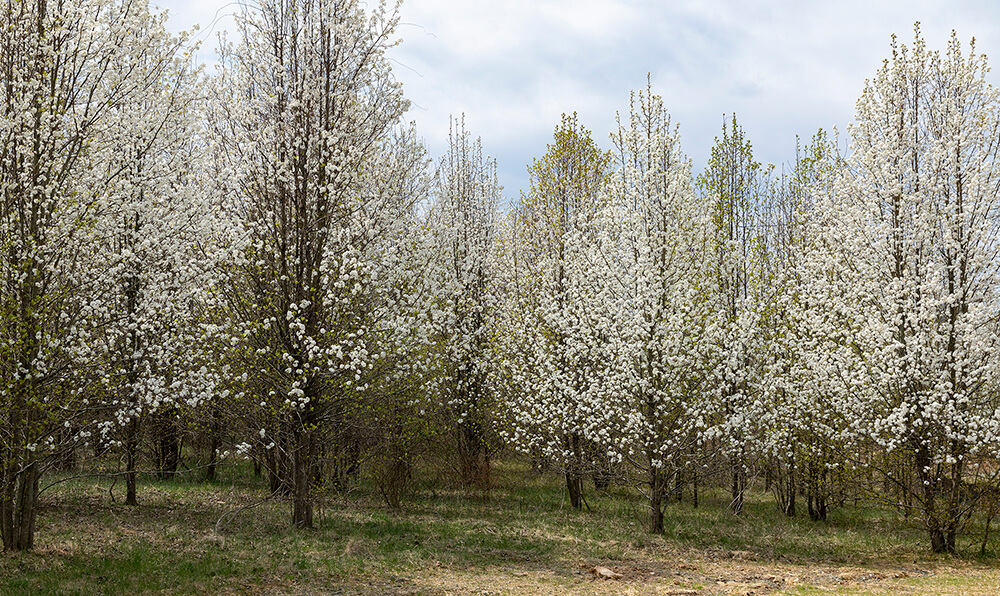DO NOT PLANT: BRADFORD PEAR
The asian import, Callery Pear (Pyrus calleryana), commonly called Bradford Pear, is an ornamental tree that’s widely used in landscaping. It has, like so many other nursery-grown plants, escaped from residential and commercial land and is designated as invasive in more than half of our states. This tree greedily invades natural habitats and out-competes our valuable native species for resources.

“Do not plant” is the official advice regarding this invasive. I’d like to add, “Do not propagate” and “Do not sell.” Please! Unfortunately the Bradford Pear is legal to sell here in Virginia and I suspect this is the case in most of the states it’s sunk its insidious roots into.
“The Curse of the Bradford Pear” is a no-holds-barred look at this unfriendly tree.
If you like their white flowers and habit, here are some handsome Mid-Atlantic native alternatives to the Callery Pear for your consideration (sources noted below):
ALTERNATIVE NATIVE TREES
Common/Downy Serviceberry (Amelanchier arborea)
Light Reqirement: Sun, Part Shade, Shade
Soil Moisture: Dry, Moist
Lady Bird Johnson Wildflower Center
Canadian Serviceberry (Amelanchier canadensis)
Light Requirement: Sun, Part Shade, Shade
Soil Moisture: Moist, Wet
Lady Bird Johnson Wildflower Center
Allegheny Serviceberry (Amelanchier laevis)
Light Requirement: Sun, Part Shade, Shade
Soil Moisture: Dry, Moist
Lady Bird Johnson Wildflower Center
American Hornbeam/Ironwood (Carpinus caroliniana)
Light Requirement: Part Shade, Shade
Soil Moisture: Moist
Lady Bird Johnson Wildflower Center
Eastern Redbud (Cercis canadensis) –
Light Requirement: Part Shade, Shade
Soil Moisture: Moist
Lady Bird Johnson Wildflower Center
White Fringetree (Chionanthus virginicus)
Light Requirement: Sun, Part Shade, Shade
Soil Moisture: Dry, Moist
Lady Bird Johnson Wildflower Center
Flowering Dogwood (Cornus florida)
Light Requirement: Part Shade, Shade
Soil Moisture: Dry, Moist
Lady Bird Johnson Wildflower Center
Cockspur Hawthorne (Crataegus crus-galli)
Light Requirement: Sun, Part Shade, Shade
Soil Moisture: Dry, Moist
Lady Bird Johnson Wildflower Center
Green Hawthorne (Crataegus viridis)
Light Requirement: Part Shade, Shade
Soil Moisture: Moist, Wet
Lady Bird Johnson Wildflower Center
Sweet Crabapple (Malus coronaria)
Light Requirement: Sun, Part Shade
Soil Moisture: Moist, Wet
Lady Bird Johnson Wildflower Center
Blackgum (Nyssa sylvatica)
Note: this tree can grow to 100’
Light Requirement: Sun, Part Shade, Shade
Soil Moisture: Moist
Lady Bird Johnson Wildflower Center
Hophornbeam (Ostrya virginiana)
Light Requirement: Sun, Part Shade, Shade
Soil Moisture: Dry, Moist
Lady Bird Johnson Wildflower Center
Sourwood (Oxydendrum arboreum)
Note: Not recommended for urban areas
Water Use: Low
Light Requirement: Part Shade
Lady Bird Johnson Wildflower Center
American Plum/Wild Plum (Prunus americana)
Light Requirement: Sun, Part Shade, Shade
Soil Moisture: Dry, Moist>
Lady Bird Johnson Wildflower Center
Chickasaw plum (Prunus angustifolia)
Light Requirement: Sun , Part Shade
Soil Moisture: Dry
Lady Bird Johnson Wildflower Center
Southern Arrowwood Viburnum (Viburnum dentatum)
Light Requirement: Sun, Part Shade, Shade
Soil Moisture: Dry, Moist, Wet
Lady Bird Johnson Wildflower Center
Black Haw Viburnum (Viburnum prunifolium)
Light Requirement: Sun, Part Shade, Shade
Soil Moisture: Dry, Moist, Wet
Lady Bird Johnson Wildflower Center
SOURCES:
Invasive.org: Callery Pear
Pennsylvania Department of Conservation and Natural Resources: Callery or Bradford Pear
US Fish & Wildlife Service: Native Plants for Wildlife Habitat and Conservation Landscaping, Chesapeake Bay Watershed
USDA Forest Service: Invasive Plant Fact Sheet: Bradford Pear
Updated July 2, 2018
